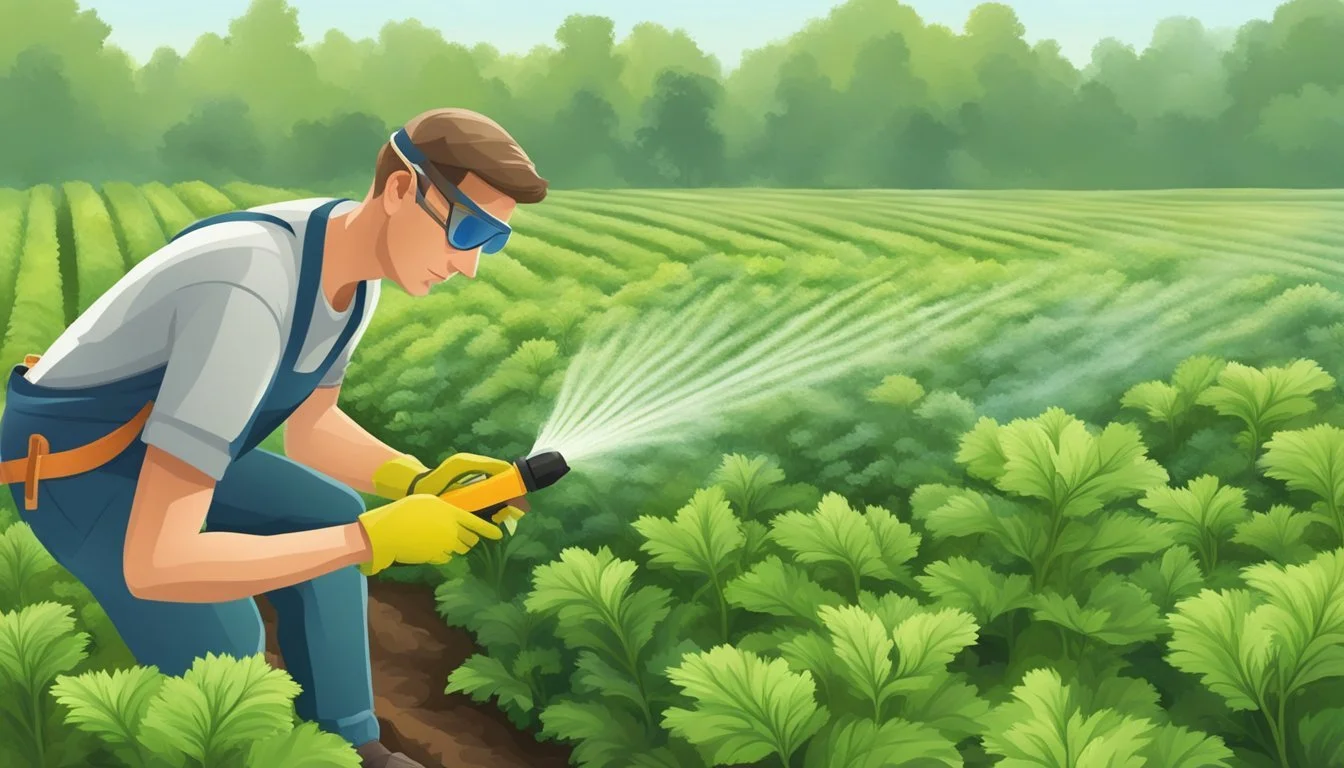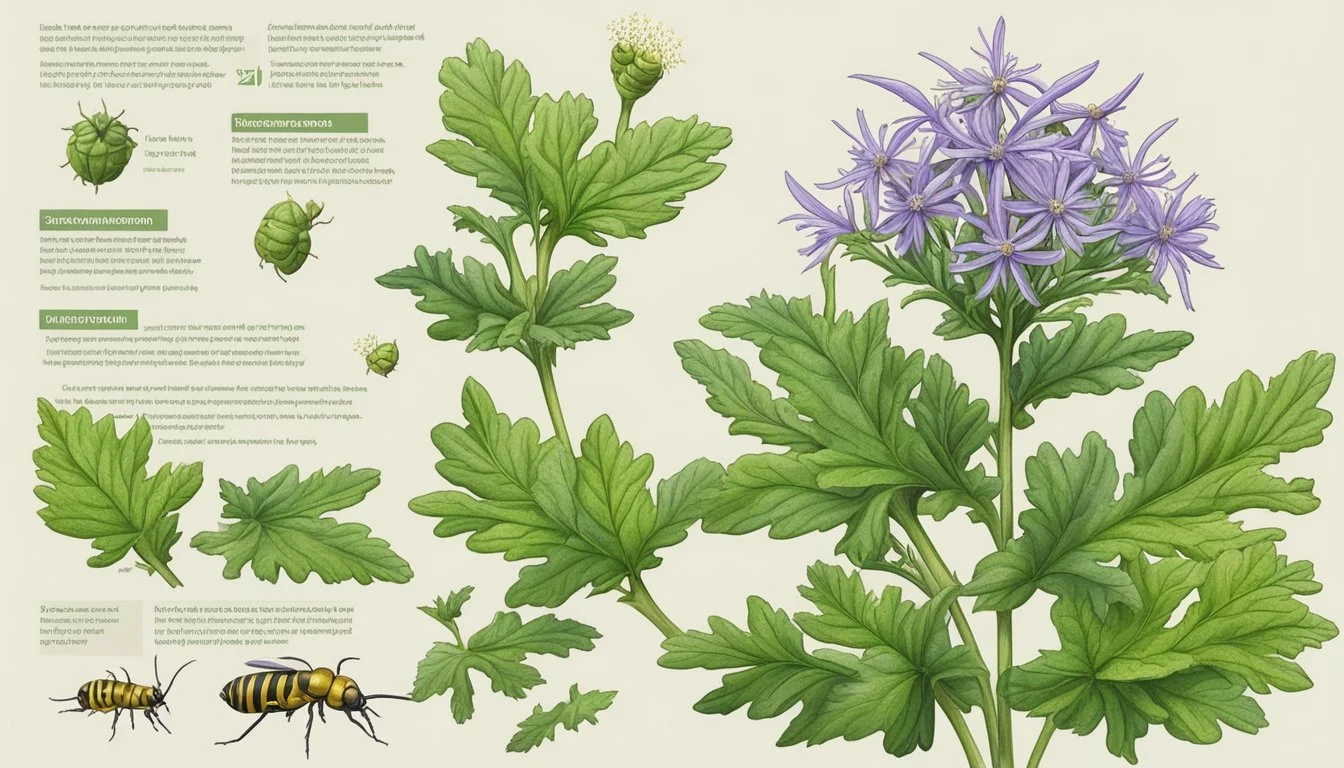Pest Control for Mizuna
Effective Strategies for Healthy Greens
Mizuna, often referred to as Japanese mustard, is a leafy green vegetable known for its peppery flavor, making it a popular choice for salads and garnishes. Cultivated widely for its hardiness and ability to grow in a range of climates, mizuna can be a great addition to any vegetable garden. However, like many crops, mizuna is susceptible to pests, which can significantly affect its growth and yield. Effective pest control is crucial to ensure a healthy harvest of these flavorful greens.
Growing mizuna requires a thoughtful approach to pest management. Gardeners should be aware of common pests that tend to target this crop, such as aphids, flea beetles, and caterpillars. These pests not only damage the leaves, making them less aesthetically pleasing for salad use, but they can also inhibit growth and even kill the plants if left uncontrolled. The key to successful mizuna cultivation lies in preventative measures and the timely identification of pest problems.
Adopting an integrated pest management (IPM) strategy is essential for minimizing the impact of pests on mizuna. This includes regular monitoring of the plants, employing physical barriers such as row covers, and encouraging the presence of beneficial insects that prey on mizuna pests. Organic solutions, like neem oil or insecticidal soap, can also be effective tools against infestations without resorting to harsh chemical pesticides. By preserving the integrity of mizuna through careful pest control, gardeners can ensure their Japanese mustard leaves are ready for the salad bowl in optimal condition.
Understanding Mizuna
Mizuna is a versatile leafy green with origins in Japan, known for its peppery flavor and tender texture. It's a nutritious vegetable that can be used in various culinary applications and offers a range of cultivars.
Origins and Characteristics
Mizuna, or Kyona, is a traditional Japanese green from the Brassica family, which originated in East Asia. It's characterized by its fringed leaves and peppery taste, resembling arugula (how long does arugula last?). Gardeners appreciate Mizuna for its fast growth and ability to withstand cool temperatures, making it an excellent choice for planting in diverse climates.
Nutritional Profile
This leafy green is high in vitamins and provides a variety of nutrients. It's particularly rich in vitamin C and K, folate, and iron. The nutritional benefits of Mizuna make it a healthy addition to salad mixes and other dishes that require fresh, nutrient-dense ingredients.
Cultivars and Varieties
Mizuna offers several cultivars including Beni Houshi, a variety with reddish-purple leaves, and Red Komatsuna, which is related but distinct, featuring darker leaves. These varieties, along with the common green Mizuna, allow for a diverse range of textures and flavors in cooking and raw applications.
Mizuna in Cuisine
In cuisine, Mizuna's tender leaves are often used in salads, stir-fries, and soups. Its peppery flavor adds depth to dishes and pairs well with milder greens like lettuce. Its versatility allows it to be included in both cooked and raw preparations, showcasing its adaptability in various culinary styles.
Comparing Mizuna to Relatives
Mizuna is often compared to its relatives in the Brassica family, such as arugula, lettuce, and mustard greens. While it shares a similar peppery taste with arugula and mustard greens, Mizuna's leaves are typically more tender, and its flavor is less intense, making it a suitable substitute in recipes where a milder green is desired.
Cultivation Essentials
A successful mizuna crop hinges on proper soil preparation, precise sowing techniques, understanding its ideal growing conditions, consistent plant maintenance, and vigilant pest and disease management.
Soil Preparation
Mizuna grows best in a well-drained soil enriched with plenty of organic matter. Gardeners should ensure the soil is loose and fertile, ideally with a pH between 6.0 and 7.0.
Sowing Techniques
Sow seeds directly into the garden around two weeks before the last spring frost. Plant seed 1/4 inch deep, spacing them about 1 inch apart. Seeds can also be scattered broadly; this method is known as broadcasting.
Ideal Growing Conditions
This green thrives when exposed to full sun but also does well in partial shade, especially during the hot summer months. Mizuna prefers cooler temperatures and can be grown in the early spring, fall, and, in some zones, during winter.
Plant Maintenance
Regular watering is crucial to maintaining mizuna, keeping the soil moist but not waterlogged. An application of a mild fertilizer, such as fish emulsion, can promote vigorous growth. A layer of mulch can aid in soil moisture retention.
Pest and Disease Management
Mizuna is prone to infestations of flea beetles and aphids. Using row covers can effectively shield the plants from pests. For slugs and mold, proper spacing and air circulation are critical preventative measures. Organic pesticides may be used in accordance with integrated pest management (IPM) practices.
Practical Tips for Gardeners
When cultivating mizuna, attention to detail in planting, care, and harvesting can significantly impact your success. Follow these targeted strategies to foster healthy growth and a bountiful harvest of this leafy green.
Planting and Spacing
For optimal growth, mizuna should be planted 1/4 inch deep in the garden bed, ensuring 1 inch apart spacing to allow for ample airflow and growth. A sunny location is ideal for planting as mizuna thrives in full to partial sunlight. Proper spacing is crucial to prevent overcrowding and to minimize the risk of disease.
Watering and Care
Keep the soil evenly moist, especially in dry conditions. Mizuna requires consistent watering, so the soil remains hydrated but not waterlogged. Regular maintenance includes weed control and providing support through organic matter such as mulch, which helps retain soil moisture and regulate temperature during cold weather.
Harvesting Techniques
Employing a cut-and-come-again method allows mizuna to regrow for multiple harvests. Begin harvesting by snipping leaves at about 4 inches in length. This encourages new growth and extends the harvest period.
Sustainable Practices
Incorporating sustainable practices involves using organic matter in the soil and applying mulch. Utilize row covers to protect mizuna from pests and extend its season. As a biennial, mizuna can be left to go to seed in the second year for seed saving.
Succession Planting
Succession planting maximizes yield by staggering the times you sow seeds. Plant new seeds every two to three weeks to ensure a continuous supply of mizuna through the season. Be mindful of spacing and garden plan to accommodate the growth of each batch.
Using Containers
If space is limited, mizuna can flourish in containers. Choose a pot with a minimum width of 12 inches and ensure it has drainage holes. Fill with quality potting mix and sow mizuna seeds thinly, providing the same care as in-ground plants for a successful container garden.
Challenges and Solutions
Gardeners frequently encounter specific challenges when cultivating mizuna, such as bolting due to temperature fluctuations and pest invasions that can damage crops. Addressing these issues efficiently ensures mizuna grows healthily and produces a bountiful harvest.
Dealing with Bolting
Mizuna, like many leafy greens, is prone to bolting—the premature production of flowering stems—especially in response to heat or frost. Bolting can make the leaves bitter and less palatable. To mitigate this, gardeners can:
Choose slow to bolt varieties which are more tolerant to temperature changes.
Ensure mizuna is planted in well-drained soil and implement adequate spacing to reduce stress on the plants.
Harvest leaves early, when they are young and tender, to encourage new growth and delay the bolting process.
Addressing Pest Problems
Pest issues, such as flea beetles, aphids, slugs, and mold, can significantly impact the productivity of mizuna plants. Effective pest management strategies include:
Using row covers to physically shield mizuna from pests while allowing light and water to reach the plants.
Maintaining proper garden hygiene by removing debris and weeds to minimize habitats for slugs and mold.
Encouraging beneficial insects that naturally control pest populations.
Regular inspection of plants for early detection and control of aphids and flea beetles to minimize damage.
Garden to Table
Transitioning mizuna from the garden to the table involves a series of steps that ensure its freshness and flavor are preserved. These steps include harvesting at the perfect time, integrating mizuna into a variety of dishes, and proper storage techniques.
Fresh Uses for Mizuna
Mizuna, with its peppery and slightly bitter taste, makes a fantastic addition to salads. One of the best ways to enjoy mizuna's fresh crispness is by incorporating it straight from harvest. This leafy green brings a unique flavor that complements other salad ingredients, offering a refreshing twist to traditional greens. For an exclusive salad, mix mizuna with other specialty greens, a sprinkle of seeds, and a light vinaigrette to enhance its natural taste.
Incorporating Mizuna in Dishes
Mizuna's versatility doesn't stop at salads; this green can be a key ingredient in various cooking applications. It's perfect for stir-fries, where its leaves wilt slightly but retain a nice crunch. Furthermore, mizuna's robust texture means it holds up well in soups, acting as a flavorful substitute for more common greens like spinach. Its nuanced flavor profile complements both vegetarian and meat-centric dishes, ensuring a seamless blend in a diverse array of recipes.
Storage and Preservation
To maintain mizuna's quality from harvest to meal, proper storage and preservation are essential. If not used immediately, mizuna should be kept in the refrigerator, where it can stay crisp for several days. Mizuna can be stored in a container or plastic bag with a paper towel to absorb excess moisture. When looking to preserve the greens for an extended period, blanching and freezing mizuna is an effective method to retain its nutritional value and taste for future use in cooked dishes.
Beyond the Garden
Mizuna, also known as Japanese mustard greens, is a plant with cultural importance that has found its way to various marketplaces and educational resources across the globe.
Cultural Significance
In Japan, mizuna is more than a leafy green; it's a staple in traditional dishes and plays a role in the culinary heritage of regions like Kyoto. Mizuna is often incorporated into salad mixes, praised for its mild, peppery flavor that complements a variety of Japanese and international cuisine.
Mizuna in Marketplaces
Mizuna has gained popularity beyond Japanese borders and is now commonly found in supermarkets worldwide. In addition to being sold as fresh produce, it's frequently featured in pre-packaged salad mixes. Some farms even offer exclusive promotions for their unique mizuna varieties, enticing customers to experience the unique flavors of growing mizuna at home.
Educational Resources
A variety of educational resources are available for those interested in growing mizuna, from detailed care guides to instructional videos. Agricultural extensions and gardening websites often provide comprehensive guidelines on pest control, highlighting the importance of maintaining healthy growth practices.
Companion Planting
Companion planting is a strategic gardening practice aimed at enhancing growth and natural pest control. Mizuna, a Japanese mustard green, benefits greatly from being planted alongside specific companions. Gardeners can incorporate a variety of plants to foster a healthy and productive mizuna crop.
Onions and mizuna create a harmonious relationship in the garden. The pungent aroma of onions is known to deter pests, thereby providing a protective barrier for mizuna. This mutually beneficial combination reduces the likelihood of pest infestation.
When considering lettuce, the leafy vegetable's shorter stature allows it to coexist with mizuna without competing for sunlight. Their proximity can help conserve space in the garden while enhancing biodiversity, which, in turn, can attract beneficial insects.
Here is a concise list of suitable companion plants for mizuna and their benefits:
Carrots: Assist in loosening the soil, allowing better root penetration for mizuna.
Celery: Shares similar water requirements, making irrigation more efficient.
Corn: Acts as a natural trellis, offering shade and support.
Beans: Enrich the soil with nitrogen, promoting lush mizuna leaves.
It's important to note that each companion plant contributes to the ecosystem by attracting beneficial insects, improving soil health, or providing physical support, creating a holistic environment that encourages mizuna greens to thrive. When implemented correctly, companion planting can be a powerful tool in maintaining a healthy, pest-resistant garden.
Advanced Gardening Techniques
In the quest for higher yields and healthier mizuna crops, advanced gardening techniques such as hydroponics and selective breeding play pivotal roles. Through these methods, gardeners can optimize conditions for plant growth, combat pest issues more effectively, and ensure a bountiful harvest.
Hydroponics and Mizuna
Hydroponics is the cultivation of plants in water without soil, where nutrients are delivered to the plant's roots directly through a nutrient solution. This method allows mizuna gardeners to exert greater control over the plant's environment, reducing the risk of soil-borne pests and diseases. Successful hydroponic cultivation requires careful monitoring of the nutrient solution's pH and electrical conductivity to ensure that plants receive the appropriate nutrients for optimal growth. The absence of soil also aids in the prevention of common pests that would typically infest soil-grown plants.
Selective Breeding
Selective breeding is the process of choosing specific mizuna plants with desirable traits and breeding them to produce offspring with those traits. For instance, gardeners might select for pest resistance or for plants that produce a higher seed yield. Over multiple generations, they can develop mizuna varieties that are better equipped to resist pest infestations and yield more harvest. Selective breeding can be a time-intensive process, but the results are often robust plants that can thrive in specific environments and offer improved quality and quantity of greens.
Both hydroponics and selective breeding offer mizuna cultivators sophisticated techniques that can lead to superior plants and more effective pest control, supporting the goal of sustainable and productive gardening practices.
Frequently Asked Questions
In addressing challenges with mizuna greens, understanding organic methods for pest control and steps for prevention are critical.
How can I organically control pests in my mizuna greens?
One can organically manage pests in mizuna by introducing beneficial insects, such as ladybugs, that predate on common pests. Additionally, neem oil can serve as an organic insecticide that effectively deters a wide range of insects without harm to the plants or environment.
What are effective methods to prevent flea beetle damage on mizuna?
To combat flea beetle infestations, one can employ floating row covers to block access to the plants. It's also effective to cultivate trap crops to divert flea beetles away from mizuna greens.
What steps should I take to manage mustard bug infestations?
Managing mustard bug infestations requires regular monitoring of the mizuna plants. One should remove the bugs by hand and destroy them. Additionally, crop rotation can help reduce the risk of reinfestation.
How can I identify and treat white spots on my mustard greens?
White spots on mustard greens may indicate a fungal issue such as powdery mildew. Treating the affected plants with a solution of baking soda and water can help control this fungal growth, along with ensuring good air circulation and proper spacing between plants.
What are the best practices for preventing cabbage aphids in mizuna?
Preventing cabbage aphids in mizuna involves a combination of ongoing plant inspection, spraying with water to dislodge any visible aphids, and applying organic insecticidal soaps. Introducing natural predators such as ladybugs can also be a part of an integrated pest management strategy.
Are there any safe and natural pesticides recommended for mizuna plants?
Safe and natural pesticides such as spinosad—derived from soil bacteria—or insecticidal soaps can be used on mizuna plants. They should be applied according to label instructions to effectively control insect populations while being safe for the plant and environment.










